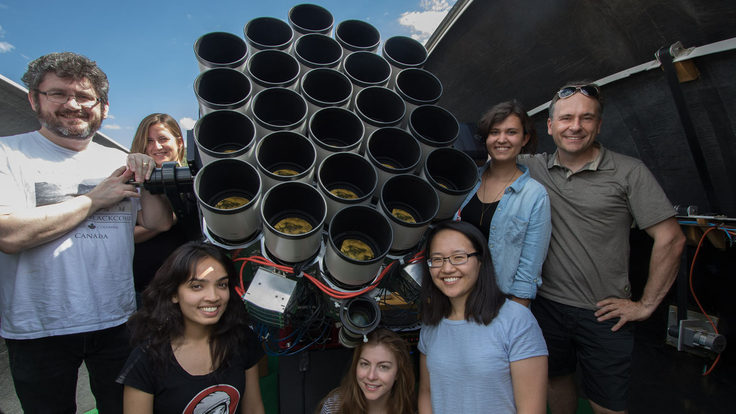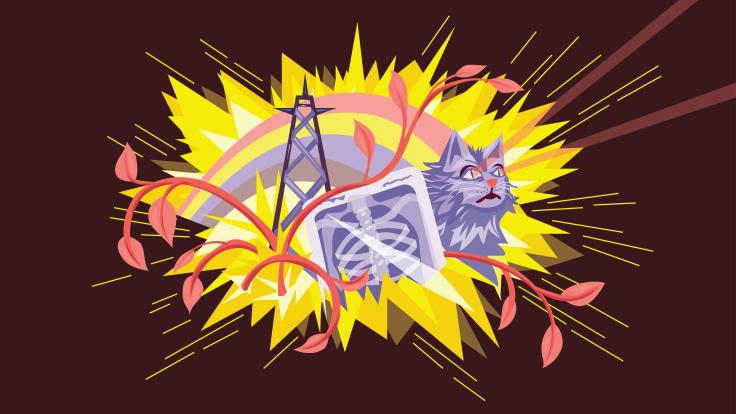SLAC Today published this story on July 1, 2011. To learn more about this scientific discovery, tune in to watch "Jurassic C.S.I.: In Living Color" on the National Geographic Channel on Thursday, July 7 at 10 p.m. ET

Research at SLAC's Stanford Synchrotron Radiation Lightsource allowed scientists to examine two fossilized birds. Confuciusornis sanctus, shown in the artist's concept above, is a species from 120 million years ago that had the first known bird-like beak.
Scientists report today that they have taken a big step in determining what the first birds looked like more than 100 million years ago, when their relatives, the dinosaurs, still ruled the Earth. At the Department of Energy’s SLAC National Accelerator Laboratory, they discovered chemical traces of a pigment, an important component of color, that once formed patterns in the feathers of the fossilized birds.
The pigment, eumelanin, is one of the coloring agents responsible for brown eyes and dark hair in many modern species, including humans. It would have been one of the factors that determined the birds’ color patterns, along with structural properties of the birds’ feathers and other pigments they ingested as part of their diets.
The discovery, reported June 30 in Science Express, will help give textbook illustrators, diorama makers and Hollywood special-effects artists a more realistic palette for their depictions of ancient animals. Understanding these pigment patterns is important for science, too, since they play a role in a wide range of behaviors that are important in evolution such as camouflage, communication and selecting mates.
"This is a pigment that evolved a very, very long time ago but is still actively synthesized by organisms on the planet, and we found a way to map it and show its presence over 120 million years of geological time passing,” said geochemist Roy Wogelius of the University of Manchester, one of the leaders of an international team that reported the discovery. “It is a direct relationship between you, me, and some extremely old organisms.”
Said report co-author Uwe Bergmann of SLAC, "If we could eventually give colors to long extinct species, that in itself would be fantastic. Synchrotron radiation has revolutionized science in many fields, most notably in molecular biology. It is very exciting to see that it is now starting to have an impact in paleontology, in a way that may have important implications in many other disciplines.”
Working at SLAC’s Stanford Synchrotron Radiation Lightsource, the researchers examined two fossilized birds. Confuciusornis sanctus, which lived 120 million years ago, was one of many evolutionary links between dinosaurs and birds, sporting the first known bird-like beak. Gansus yumenensis, considered the oldest modern bird, lived more than 100 million years ago and looked a bit like a modern grebe.
Scientists had previously found melanosomes—the biological “paint pots” where melanin pigments are made and stored—in both ancient and living organisms. They used information about the structures of the melanosomes to make an educated guess about the colors of the pigments inside. But the newly published research shows that this prior approach has limitations. The team looked instead for chemical traces of the pigments themselves with two sophisticated X-ray techniques developed at SSRL.
The first technique identifies specific chemicals or elements in a sample, and it can examine whole fossils rather than the tiny fragments used in previous methods, revealing pigment patterns across the whole specimen. With it, the researchers unveiled traces of specific elements in and around the tissues, bones and surrounding rock of Confuciusornis sanctus. These traces provide an image of the pigmentation patterns from this long-dead bird in eerie detail.
The most striking of these trace elements was copper. As Bergmann points out, copper, which can be toxic in high levels, has persisted in the fossil in significant amounts, appearing in the images as a ghostly glow in places where feathers remained. What was it doing there? Before they could answer that, the researchers had to determine what chemical form the copper took.
SSRL staff scientist Sam Webb used the second X-ray imaging technique to study the fossil of a single feather from Gansus yumenensis. His analysis revealed that the copper in the fossil took the same form as copper trapped by eumelanin pigment. What's more, Webb said, "When we looked outside the feather we didn't see the copper at all."
Couple that chemistry with the way the copper was distributed, and the research team was faced with a mind-boggling conclusion: They had seen actual color patterns in the fossil bird feathers. "There is a stunningly remarkable preservation of pigments,” Wogelius said. The team found the same relationship between copper and pigments in samples from modern feathers and squid.
“These new techniques for teasing out evidence of pigmentation will take a lot of the guesswork out of reconstructing the appearance of extinct dinosaurs and birds,” said renowned dinosaur illustrator James Gurney, author of the best-selling Dinotopia series.
The discovery opens a window on the biochemistry of ancient creatures, and could lead to a far greater understanding of what they ate and the chemistry of their surroundings.
”The fossils we excavate have vast potential to unlock many secrets about the original organism’s life, death and subsequent events impacting its preservation,” said paper co-author Phil Manning, a paleontologist at the University of Manchester. “In doing this, we unlock much more than just paleontological information. We now have a chemical roadmap to track similar pigments in all life.”






